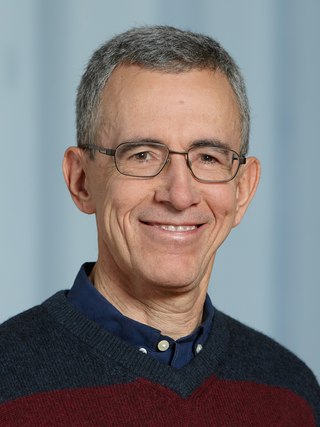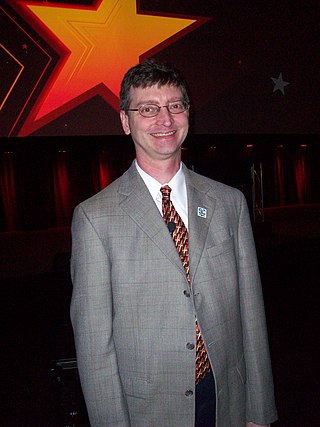Related Research Articles

David Harold Bailey is a mathematician and computer scientist. He received his B.S. in mathematics from Brigham Young University in 1972 and his Ph.D. in mathematics from Stanford University in 1976. He worked for 14 years as a computer scientist at NASA Ames Research Center, and then from 1998 to 2013 as a Senior Scientist at the Lawrence Berkeley National Laboratory. He is now retired from the Berkeley Lab.
The Royal Radar Establishment was a research centre in Malvern, Worcestershire in the United Kingdom. It was formed in 1953 as the Radar Research Establishment by the merger of the Air Ministry's Telecommunications Research Establishment (TRE) and the British Army's Radar Research and Development Establishment (RRDE). It was given its new name after a visit by Queen Elizabeth II in 1957. Both names were abbreviated to RRE. In 1976 the Signals Research and Development Establishment (SRDE), involved in communications research, joined the RRE to form the Royal Signals and Radar Establishment (RSRE).

Jack Joseph Dongarra is an American computer scientist and mathematician. He is the American University Distinguished Professor of Computer Science in the Electrical Engineering and Computer Science Department at the University of Tennessee. He holds the position of a Distinguished Research Staff member in the Computer Science and Mathematics Division at Oak Ridge National Laboratory, Turing Fellowship in the School of Mathematics at the University of Manchester, and is an adjunct professor and teacher in the Computer Science Department at Rice University. He served as a faculty fellow at the Texas A&M University Institute for Advanced Study (2014–2018). Dongarra is the founding director of the Innovative Computing Laboratory at the University of Tennessee. He was the recipient of the Turing Award in 2021.

David A. Bader is a Distinguished Professor and Director of the Institute for Data Science at the New Jersey Institute of Technology. Previously, he served as the Chair of the Georgia Institute of Technology School of Computational Science & Engineering, where he was also a founding professor, and the executive director of High-Performance Computing at the Georgia Tech College of Computing. In 2007, he was named the first director of the Sony Toshiba IBM Center of Competence for the Cell Processor at Georgia Tech. Bader has served on the Computing Research Association's Board of Directors, the National Science Foundation's Advisory Committee on Cyberinfrastructure, and on the IEEE Computer Society's Board of Governors. He is an expert in the design and analysis of parallel and multicore algorithms for real-world applications such as those in cybersecurity and computational biology. His main areas of research are at the intersection of high-performance computing and real-world applications, including cybersecurity, massive-scale analytics, and computational genomics. Bader built the first Linux supercomputer using commodity processors and a high-speed interconnection network.

Ataç İmamoğlu is a Turkish-Swiss physicist working on quantum optics and quantum computation. His academic interests are quantum optics, semiconductor physics, and nonlinear optics.
Edward Seidel is an American academic administrator and scientist serving as the president of the University of Wyoming since July 1, 2020. He previously served as the Vice President for Economic Development and Innovation for the University of Illinois System, as well as a Founder Professor in the Department of Physics and a professor in the Department of Astronomy at the University of Illinois at Urbana-Champaign. He was the director of the National Center for Supercomputing Applications at Illinois from 2014 to 2017.
David E. Keyes is a Senior Associate to the President of King Abdullah University of Science and Technology (KAUST) and the Director of the Extreme Computing Center at King Abdullah University of Science and Technology (KAUST). He was the inaugural Dean of the Division of Computer, Electrical, and Mathematical Sciences and Engineering (CEMSE) at KAUST and remains an adjunct professor in Applied Physics and Applied Mathematics at Columbia University and an affiliate of several laboratories of the U.S. Department of Energy. With backgrounds in engineering, applied mathematics, and computer science, he works at the algorithmic interface between parallel computing and the numerical analysis of partial differential equations, across a spectrum of aerodynamic, geophysical, and chemically reacting flows.

William Douglas Gropp is the director of the National Center for Supercomputing Applications (NCSA) and the Thomas M. Siebel Chair in the Department of Computer Science at the University of Illinois at Urbana–Champaign. He is also the founding Director of the Parallel Computing Institute. Gropp helped to create the Message Passing Interface, also known as MPI, and the Portable, Extensible Toolkit for Scientific Computation, also known as PETSc.

Phillip Colella is an American applied mathematician and a member of the Applied Numerical Algorithms Group at the Lawrence Berkeley National Laboratory. He has also worked at Lawrence Livermore National Laboratory. He is known for his fundamental contributions in the development of mathematical methods and numerical tools used to solve partial differential equations, including high-resolution and adaptive mesh refinement schemes. Colella is a member of the US National Academy of Sciences.
The Sidney Fernbach Award established in 1992 by the IEEE Computer Society, in memory of Sidney Fernbach, one of the pioneers in the development and application of high performance computers for the solution of large computational problems as the Division Chief for the Computation Division at Lawrence Livermore Laboratory from the late 1950s through the 1970s. A certificate and $2,000 are awarded for outstanding contributions in the application of high performance computers using innovative approaches. The nomination deadline is 1 July each year.
The Seymour Cray Computer Engineering Award, also known as the Seymour Cray Award, is an award given by the IEEE Computer Society, to recognize significant and innovative contributions in the field of high-performance computing. The award honors scientists who exhibit the creativity demonstrated by Seymour Cray, founder of Cray Research, Inc., and an early pioneer of supercomputing. Cray was an American electrical engineer and supercomputer architect who designed a series of computers that were the fastest in the world for decades, and founded Cray Research which built many of these machines. Called "the father of supercomputing," Cray has been credited with creating the supercomputer industry. He played a key role in the invention and design of the UNIVAC 1103, a landmark high-speed computer and the first computer available for commercial use.
Roberto Car is an Italian physicist and the Ralph W. Dornte *31 Professor in Chemistry at Princeton University, where he is also a faculty member in the Princeton Institute for the Science and Technology of Materials. He conducts research on the simulation of molecular dynamics phenomena.
Michael John Creutz is an American theoretical physicist at Brookhaven National Laboratory specializing in lattice gauge theory and computational physics.

Christopher Ray Johnson is an American computer scientist. He is a distinguished professor of computer science at the University of Utah, and founding director of the Scientific Computing and Imaging Institute (SCI). His research interests are in the areas of scientific computing and scientific visualization.
John B. Bell is an American mathematician and the Chief Scientist of the Computational Research Division at the Lawrence Berkeley National Laboratory. He has made contributions in the areas of finite difference methods, numerical methods for low Mach number flows, adaptive mesh refinement, interface tracking and parallel computing. He has also worked on the application of these numerical methods to problems from a broad range of fields, including combustion, shock physics, seismology, flow in porous media and astrophysics.

James Weldon Demmel Jr. is an American mathematician and computer scientist, the Dr. Richard Carl Dehmel Distinguished Professor of Mathematics and Computer Science at the University of California, Berkeley.

Michele Parrinello is an Italian physicist particularly known for his work in molecular dynamics. Parrinello and Roberto Car were awarded the Dirac Medal and the Sidney Fernbach Award in 2009 for their continuing development of the Car–Parrinello method, first proposed in their seminal 1985 paper, "Unified Approach for Molecular Dynamics and Density-Functional Theory". They have continued to receive awards for this breakthrough, most recently the Dreyfus Prize in the Chemical Sciences and the 2020 Benjamin Franklin Medal in Chemistry.
Robert J. Harrison is a distinguished expert in high-performance computing. He is a professor in the Applied Mathematics and Statistics department and founding Director of the Institute for Advanced Computational Science at Stony Brook University with a $20M endowment. Through a joint appointment with Brookhaven National Laboratory, Professor Harrison has also been named Director of the Computational Science Center and New York Center for Computational Sciences at Brookhaven. Dr. Harrison comes to Stony Brook from the University of Tennessee and Oak Ridge National Laboratory, where he was Director of the Joint Institute of Computational Science, Professor of Chemistry and Corporate Fellow. He has a prolific career in high-performance computing with over one hundred publications on the subject, as well as extensive service on national advisory committees.

Alan Stuart Edelman is an American mathematician and computer scientist. He is a professor of applied mathematics at the Massachusetts Institute of Technology (MIT) and a Principal Investigator at the MIT Computer Science and Artificial Intelligence Laboratory (CSAIL) where he leads a group in applied computing. In 2004, he founded a business called Interactive Supercomputing which was later acquired by Microsoft. Edelman is a fellow of American Mathematical Society (AMS), Society for Industrial and Applied Mathematics (SIAM), Institute of Electrical and Electronics Engineers (IEEE), and Association for Computing Machinery (ACM), for his contributions in numerical linear algebra, computational science, parallel computing, and random matrix theory. He is one of the cocreators of the technical programming language Julia.
Marsha J. Berger is an American computer scientist. Her areas of research include numerical analysis, computational fluid dynamics, and high-performance parallel computing. She is a Silver Professor (emeritus) of Computer Science and Mathematics in the Courant Institute of Mathematical Sciences of New York University. She is Group Leader of Modeling and Simulation in the Center for Computational Mathematics at the Flatiron Institute.
References
- ↑ Murray, Charles (1997). The Supermen: The Story of Seymour Cray and the Technical Wizards Behind the Supercomputer. Wiley. p. 59. ISBN 978-0471048855.
- ↑ IEEE Computer Society: Sidney Fernbach